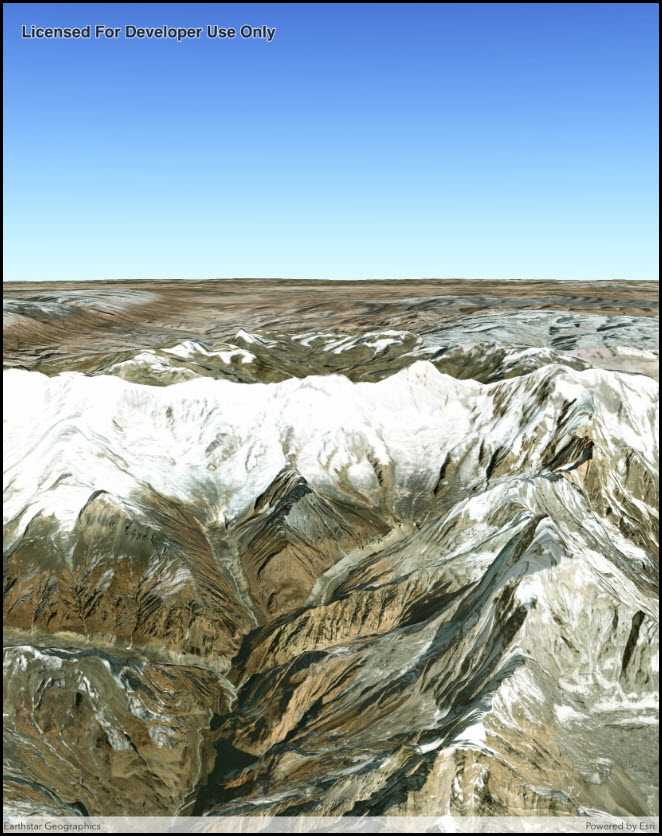Display a scene with a terrain surface and some imagery.

Use case
Scene views are 3D representations of real-world areas and objects. Scene views are helpful for visualizing complex datasets where 3D relationships, topography, and elevation of elements are important factors.
How to use the sample
When loaded, the sample will display a scene. Pan and zoom to explore the scene.
How it works
- Create a
Sceneobject with theBasemapStyle.ArcGISImageryStandardbasemap style. - Create an
ArcGISTiledElevationSourceobject and add it to the scene's base surface. - Create a
SceneViewobject to display the map. - Set the scene to the scene view.
Relevant API
- Scene
- ArcGISTiledElevationSource
- SceneView
Tags
3D, basemap, elevation, scene, surface
Sample Code
DisplayScene.cs
// Copyright 2017 Esri.
//
// Licensed under the Apache License, Version 2.0 (the "License"); you may not use this file except in compliance with the License.
// You may obtain a copy of the License at: http://www.apache.org/licenses/LICENSE-2.0
//
// Unless required by applicable law or agreed to in writing, software distributed under the License is distributed on an
// "AS IS" BASIS, WITHOUT WARRANTIES OR CONDITIONS OF ANY KIND, either express or implied. See the License for the specific
// language governing permissions and limitations under the License.
using System;
using Esri.ArcGISRuntime.Mapping;
using Esri.ArcGISRuntime.UI.Controls;
using Foundation;
using UIKit;
namespace ArcGISRuntime.Samples.DisplayScene
{
[Register("DisplayScene")]
[ArcGISRuntime.Samples.Shared.Attributes.Sample(
name: "Display a scene",
category: "Layers",
description: "Display a scene with a terrain surface and some imagery.",
instructions: "When loaded, the sample will display a scene. Pan and zoom to explore the scene.",
tags: new[] { "3D", "basemap", "elevation", "scene", "surface" })]
public class DisplayScene : UIViewController
{
// Hold references to UI controls.
private SceneView _mySceneView;
public DisplayScene()
{
Title = "Display scene";
}
private void Initialize()
{
// Create a new basemap.
Basemap imageryBasemap = new Basemap(BasemapStyle.ArcGISImageryStandard);
// Create and show a new scene with imagery basemap.
_mySceneView.Scene = new Scene(imageryBasemap);
// Create a new surface.
Surface surface = new Surface();
// Define the string that points to the elevation image service.
const string elevationImageService = "https://elevation3d.arcgis.com/arcgis/rest/services/WorldElevation3D/Terrain3D/ImageServer";
// Create an ArcGIS tiled elevation.
ArcGISTiledElevationSource myArcGISTiledElevationSource = new ArcGISTiledElevationSource
{
// Set the ArcGIS tiled elevation sources property to the Uri of the elevation image service.
Source = new Uri(elevationImageService)
};
// Add the ArcGIS tiled elevation source to the surface's elevated sources collection.
surface.ElevationSources.Add(myArcGISTiledElevationSource);
// Set the scene's base surface to the surface with the ArcGIS tiled elevation source.
_mySceneView.Scene.BaseSurface = surface;
// Create camera with an initial camera position (Mount Everest in the Alps mountains).
Camera camera = new Camera(28.4, 83.9, 10010.0, 10.0, 80.0, 0);
// Set the scene view's camera position.
_mySceneView.SetViewpointCameraAsync(camera);
}
public override void ViewDidLoad()
{
base.ViewDidLoad();
Initialize();
}
public override void LoadView()
{
// Create the views.
View = new UIView() { BackgroundColor = ApplicationTheme.BackgroundColor };
_mySceneView = new SceneView();
_mySceneView.TranslatesAutoresizingMaskIntoConstraints = false;
// Add the views.
View.AddSubviews(_mySceneView);
// Lay out the views.
NSLayoutConstraint.ActivateConstraints(new[]
{
_mySceneView.TopAnchor.ConstraintEqualTo(View.SafeAreaLayoutGuide.TopAnchor),
_mySceneView.BottomAnchor.ConstraintEqualTo(View.BottomAnchor),
_mySceneView.LeadingAnchor.ConstraintEqualTo(View.LeadingAnchor),
_mySceneView.TrailingAnchor.ConstraintEqualTo(View.TrailingAnchor)
});
}
}
}